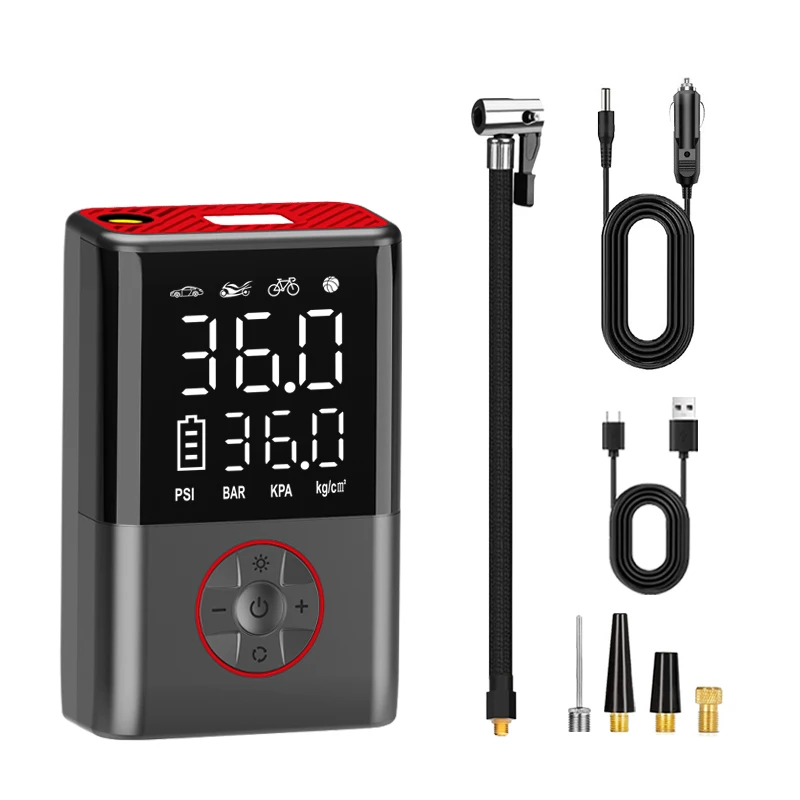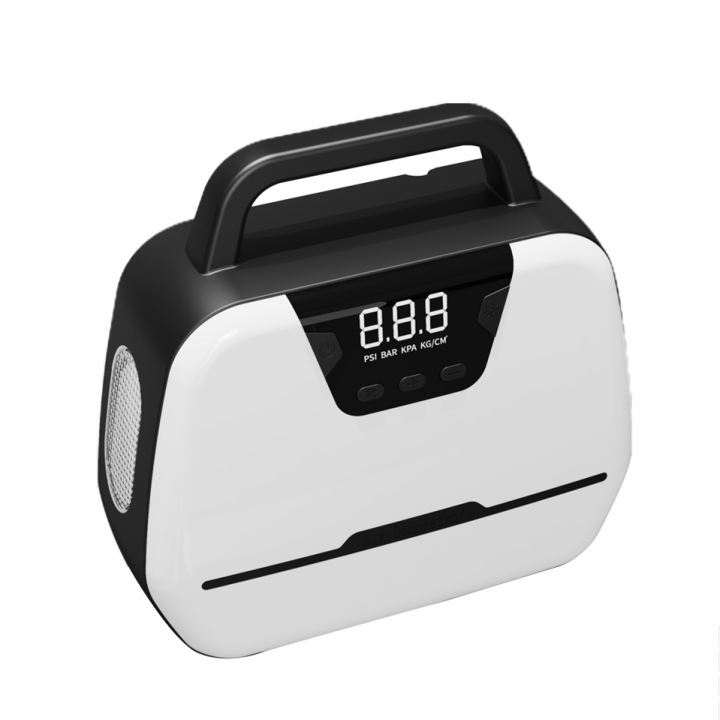När det gäller att bibehålla rätt däcktryck och hantera bilvägsnödsituationer kan valet av rätt bilkompressor göra skillnaden mellan en liten olägenhet och ett stort problem. Moderna förare står inför ett avgörande val mellan portabla och fastmonterade bilkompressorsystem, där varje typ erbjuder tydliga fördelar beroende på dina specifika behov, budget och användningsmönster. Att förstå de grundläggande skillnaderna mellan dessa två kompressortyper hjälper dig att fatta ett välgrundat köpbeslut som överensstämmer med dina krav på bilunderhåll och livsstil.

Bilreparationsmarknaden har utvecklats avsevärt under det senaste decenniet, med luftkompressorteknik som blivit mer sofistikerad, effektiv och användarvänlig. Oavsett om du är en daglig pendling, veckoslutens äventyrare eller professionell mekaniker kräver valet av lämplig kompressortyp noggrann övervägning av faktorer såsom effektleverans, portabilitetskrav, installationskomplexitet och långsiktig hållbarhet. Denna omfattande analys kommer att undersöka varje aspekt av bärbara kontra fasta bil-luftkompressorsystem för att vägleda ditt köpsbeslut.
Förståelse av bärbara bil-luftkompressorsystem
Designegenskaper och rörlighetsfunktioner
Bärbara bilkompressorer är konstruerade för maximal bekvämlighet och mångsidighet, och har oftast kompakta design som gör det enkelt att förvara dem i bagageutrymmen, handsksfack eller nödutrustning. Dessa system ansluts vanligtvis direkt till fordonets 12-voltuttag eller tändsticksuttag, vilket eliminerar behovet av permanent installation eller komplicerade ändringar i elsystemet. De flesta bärbara modeller väger mellan två och tio kilo, vilket gör dem lätthanterliga för förare av alla åldrar och fysiska förmågor.
Konstruktionen av portabla kompressorer betonar hållbarhet samtidigt som lättviktsegenskaper upprätthålls genom användning av högkvalitativa plaster, aluminiumkomponenter och effektiva motorkonstruktioner. Många moderna modeller har inbyggd LED-belysning för användning om natten, digitala tryckmätare för noggranna avläsningar samt förinställda trycknivåer som automatiskt stängs av när önskad fyllnivå uppnås. Dessa bekvämlighetsfunktioner har förvandlat portabla kompressorer från enkla nödverktyg till sofistikerade bilaccessoarer.
Prestandaspecifikationer och begränsningar
Prestanda för portabla kompressorer varierar avsevärt mellan olika prispunkter och tillverkare, där de flesta enheter levererar mellan 35 och 150 PSI som maximalt tryck. Högrepricede portabla modeller kan fylla standarddäck för personbilar från platt till fullt tryck på ungefär 3–8 minuter, medan billigare alternativ kan kräva 10–15 minuter för samma uppgift. Driftscykeln för portabla enheter tillåter vanligtvis 10–15 minuters kontinuerlig användning innan svalningsperioder krävs för att förhindra motoröverhettning.
Energiförbrukning utgör en annan viktig faktor, eftersom portabla kompressorer förbrukar mellan 10–15 ampere från fordonets elsystem under drift. Detta effektkrav innebär att om kompressorn används med motorn avstängd kan det tömma bilens batteri, särskilt i äldre fordon med reducerad batterikapacitet. De flesta tillverkare rekommenderar att portabla kompressorer används med motorn igång för att säkerställa tillräcklig strömförsörjning och förhindra urladdning av batteriet vid längre inflationssessioner.
Granskning av fasta bil-luftkompressorsystem
Installationskrav och permanent montering
Fast installerade luftkompressorsystem för bil kräver permanent installation i fordonet, vanligtvis monterade i motorutrymmet, bagageutrymmet eller dedikerade förvaringsutrymmen beroende på fordonets konfiguration. Installationsprocessen innebär att koppla kompressorn direkt till fordonets elfsystem via specifika kablage, vilket ofta kräver professionell installation eller avancerade DIY-mekanikfärdigheter. Dessa system inkluderar vanligtvis separata lufttankar för trycklagring och distributionsledningar som kan förläggas till flera åtkomstpunkter genom hela fordonet.
Monteringshårdvaran för fasta system måste vara tillräckligt robust för att tåla fordonets vibrationer, temperatursvängningar och potentiella påverkanskrfter under normala körförhållanden. Professionell installation säkerställer korrekta elektriska anslutningar, tillräcklig ventilation för värmeavledning samt säker fästning som inte påverkar andra fordonsystem eller komponenter. Många fasta kompressorinstallationer inkluderar också tryckbrytare, säkerhetsventiler och övervakningssystem som integreras med fordonets befintliga el- och instrumentpanelsystem.
Effektuttag och tunga applikationer
Fast monterade kompressorsystem levererar vanligtvis avsevärt högre effektuttag jämfört med portabla alternativ, där många modeller producerar 200–300 PSI eller högre maximaltryck. Denna ökade kapacitet gör fasta system idealiska för större fordon, kommersiella tillämpningar eller situationer som kräver snabb inblåsning av flera däck eller luftverktyg med hög volym. Fastkompressorernas kontinuerliga driftscykler överstiger ofta de portabla enheternas med betydande marginal, vilket möjliggör förlängd användning utan obligatoriska svalningsperioder.
Luftlagringskapaciteten i fasta system ger omedelbar tillgång till tryckluft utan att behöva vänta på kompressor drift, vilket gör dem särskilt värdefulla för tidskrävande applikationer eller nödsituationer. Tankvolymerna ligger vanligtvis mellan en och fem gallon, vilket ger tillräcklig luftvolym för flera däckpumpningar eller för att driva pneumatiska verktyg och tillbehör. Denna lagringsförmåga utgör en betydande fördel jämfört med portabla kompressorer som måste köras kontinuerligt under användning.
Kostnadsanalys och värdesökande
Inledande inköps- och installationsutgifter
Den ekonomiska investeringen som krävs för bilers luftkompressorsystem varierar kraftigt mellan portabla och fasta alternativ, där portabla enheter i basmodell börjar på cirka trettio till femtio dollar och professionella modeller kan nå flera hundra dollar. Kostnaden för fasta system börjar vanligtvis på cirka tvåhundra dollar för grundläggande konfigurationer och kan överstiga tusen dollar för omfattande installationer inklusive tankar, flera uttag och integrerade övervakningssystem. Professionella installationskostnader för fasta system lägger till ytterligare tvåhundra till femhundra dollar beroende på komplexitet och arbetskostnader.
När du bedömer den totala ägandekostnaden bör du ta hänsyn till livslängd och hållbarhets skillnader mellan systemtyper, eftersom fasta installationer ofta erbjuder årtionden av pålitlig drift med minimala underhållskrav. Portabla enheter kan behöva bytas ut vartannat år beroende på användningsfrekvens och byggkvalitet, vilket potentiellt kan göra fasta system mer ekonomiska över längre tidsperioder. Dessutom kan fasta system öka värdeför bilen vid återförsäljning, särskilt för lastbilar, SUV:er och fritidsfordon där kompressorkapacitet är högt värderad av potentiella köpare.
Långsiktiga underhålls- och driftskostnader
Underhållskraven skiljer sig väsentligt mellan portabla och fasta bils luftkompressor system, där portabla enheter vanligtvis kräver minimalt underhåll utöver tillfälligt rengöring och kontroll av sladdar. Fasta system kräver mer omfattande underhåll, inklusive byte av luftfilter, tömning av tankar för att ta bort fuktsamling samt periodisk kontroll av monteringsdelar och elektriska anslutningar. Tack vare den robusta konstruktionen har dock fasta system generellt lägre felfrekvens och sällanare behov av utbyte jämfört med portabla alternativ.
Driftskostnaderna förblir minimala för båda systemtyperna, eftersom elförbrukningen vid normal användning har försumbar inverkan på bränsleekonomi eller batterilivslängd när motorer är igång. Fastmonterade system kan erbjuda lätt effektivitetsfördelar genom minskade el-förluster och optimerad motordrift, medan portabla enheter erbjuder flexibilitet att användas i flera fordon utan ytterligare installationskostnader. Överväg dina specifika användningsmönster och fordonsegenskapsvanor när du bedömer driftsekonomi på lång sikt.
Prestandajämförelse i verkliga tillämpningar
Nödsituationer vid vägkanten
Vid vägkantsnödsituationer är portabla kompressorer idealiska i situationer som kräver omedelbar användning utan förberedelsetid eller installationsförfaranden. Möjligheten att snabbt ansluta till strömkällor och påbörja uppblåsning ger avgörande fördelar vid plötslig däcktrycksförlust, särskilt i dåliga väderförhållanden eller osäkra platser längs vägen. Portabla enheter kan köras från insidan av fordonet under dåligt väder, vilket erbjuder skydd och komfort medan man åtgärdar däcktrycksproblem.
Fixa system ger överlägsen prestanda i nödsituationer med flera punkteringar, fullständig avtryckning eller situationer som kräver kontinuerlig högtrycksavgivning. Den lagrade luftkapaciteten i fastmonterade tankar möjliggör omedelbar avmatning av stora luftmängder utan att behöva vänta på kompressor drift, vilket potentiellt kan minska tiden exponerad vid vägkanten och förbättra säkerheten. Fast monterade system kan dock inte hjälpa andra fordon eller användas bortom det egna fordonet, vilket begränsar deras användbarhet vid gruppresa eller i nödassistanssituationer.
Regelbunden underhåll och förebyggande skötsel
För rutinmässig underhåll av däcktryck och säsongsbaserade justeringar erbjuder båda systemtyperna distinkta fördelar beroende på din underhållsmetod och lagringsmöjligheter. Bärbara kompressorer ger flexibilitet för användning i garage, lagringsbyggnader eller underhållsarbete som involverar flera fordon inom en privatbilflotta. Möjligheten att flytta de bärbara enheterna mellan olika platser gör dem idealiska för hushåll med begränsat garageutrymme eller för dem som utför fordonunderhåll på olika platser.
Fixa installationer är utmärkta för kommersiella applikationer eller situationer som innebär frekventa justeringar av däcktryck, till exempel terrängfordon som regelbundet ändrar däcktryck för olika terrängförhållanden. Bekvämligheten med permanent tillgänglig tryckluft eliminerar installationsåtgång och uppmuntrar till regelbunden tryckövervakning, vilket potentiellt kan förlänga däckens livslängd och förbättra fordonets prestanda genom konsekvent underhåll. Integration med fordonets elsystem kan också möjliggöra automatiska system för tryckövervakning och -justering i avancerade installationer.
Urvalskriterier baserat på fordonstyp och användning
Personbilar och dagliga pendlingfordon
De flesta personbilsapplikationer föredrar portabla kompressorlösningar på grund av platsbegränsningar, måttliga prestandakrav och kostnadshänseenden som prioriterar värde framför maximal kapacitet. Standardens krav på däckvolym och tryck för personbilar ligger väl inom driftkapaciteten för kvalitetsportabla kompressorer, vilket gör den extra kostnaden och komplexiteten med fasta system svår att motivera för vanliga pendlingsscheman. Den sällsynta karaktären av justeringar av däcktryck i personbilar passar väl ihop med portabla kompressorers arbetscykler och prestandaegenskaper.
Lyxfordon och högpresterande bilar kan dra nytta av fasta systeminstallationer när luftfjädringssystem, prestandahantering av däck eller integrerade fordonsystem kräver konsekvent tillgång till komprimerad luft. Den estetiska och funktionella integration som är möjlig med fasta installationer tilltalar ägare som sätter värde på smidiga fordonmodifieringar och omfattande fordonsystem. Tänk på ditt fordon:s befintliga system och modifieringsmål när du bedömer kompressoralternativ för premium personbilar.
Lastbilar, SUV:er och kommersiella applikationer
Större fordon inklusive pickupar, SUV:er och kommersiella fordon motiverar ofta fasta kompressorinstallationer genom ökade däckvolymer, högre trygkrav och frekventa användningsmönster som överstiger portabla kompressors kapacitet. Dessa fordons dragkrafts- och lastegenskaper skapar situationer där snabb justering av däcktryck blir avgörande för säkerhet och prestandaoptimering. Fasta system ger den uthålliga effekten som krävs för att fylla upp flera stora däck eller driva luftdrivna verktyg och tillbehör.
Arbetslastbilar och kommersiella fordon drar ofta nytta av fasta kompressorinstallationer som stödjer pneumatiska verktyg, luftstyrd utrustning och specialtillbehör som förbättrar produktivitet och kapacitet. Möjligheten att driva luftverktyg utan externa kompressorer eller strömkällor ger betydande fördelar inom bygg-, underhålls- och serviceapplikationer. Tänk på hela systemkraven inklusive verktyg, tillbehör och driftskrav när du specifierar fasta kompressorsystem för kommersiella applikationer.
Vanliga frågor
Hur länge håller bärbara bilkompressorer vanligtvis med regelbunden användning
Kvalitetsbästa portabla bilkompressorer klarar vanligtvis tre till fem års pålitlig användning med månatlig användning, medan budgetmodeller kan behöva bytas ut efter ett till två år beroende på byggkvalitet och driftskrav. Faktorer som påverkar livslängden inkluderar följsamhet till arbetscykeln, korrekta förvaringsförhållanden och underhållsrutiner såsom att hålla luftintagsfilter rena och undvika fuktpåverkan. Portabla enheter i högre prissegment med metallkonstruktion och kvalitetsmotorer överstiger ofta fem år med rätt vård och måttlig användning.
Kan fasta bilkompressorsystem överföras mellan fordon
Fast monterade kompressorsystem kan tekniskt överföras mellan fordon, men processen innebär vanligtvis omfattande modifieringar, omkablagning och potentiella kompatibilitetsproblem som gör överföringen opraktisk och dyr. Den anpassade monteringen, elektriska integrationen och luftledningsrouting som krävs för korrekt installation innebär att fasta system i praktiken utgör permanenta fordonmodifikationer. De flesta ägare finner det mer kostnadseffektivt att installera nya system i olika fordon istället för att försöka överföra befintliga fasta installationer.
Vilka strömkonsekvenser bör jag ta hänsyn till för körning av bilens luftkompressor
Bärbara kompressorer förbrukar vanligtvis 10–15 ampere från 12-volts fordonselektriska system och kräver motorstart vid längre användning för att förhindra urladdning av batteriet i de flesta fordon. Fasta system kan kräva dedikerade strömkretsar och högre amperagekapacitet beroende på motorns specifikationer och driftkrav. Tänk på din vagns generatorkapacitet, batteritillstånd och elektriska systemets kapacitet när du väljer kompressorsystem, särskilt för högprestandaapplikationer eller kontinuerliga driftskrav.
Finns det lagliga eller försäkringsmässiga överväganden för installation av fasta luftkompressorsystem
De flesta jurisdiktioner reglerar inte fasta luftkompressorinstallationer för personbilar, men kommersiella fordon kan omfattas av specifika utrustningsförordningar och granskningskrav beroende på användning och klassificering. Försäkringsmässiga överväganden fokuserar vanligtvis på korrekt installationspraxis och efterlevnad av tillverkarens specifikationer snarare än utrustningen i sig. Dokumentation av professionell installation kan krävas för att garanti ska gälla och kan ge skydd mot ansvar vid systemrelaterade problem eller olyckor.
Innehållsförteckning
- Förståelse av bärbara bil-luftkompressorsystem
- Granskning av fasta bil-luftkompressorsystem
- Kostnadsanalys och värdesökande
- Prestandajämförelse i verkliga tillämpningar
- Urvalskriterier baserat på fordonstyp och användning
-
Vanliga frågor
- Hur länge håller bärbara bilkompressorer vanligtvis med regelbunden användning
- Kan fasta bilkompressorsystem överföras mellan fordon
- Vilka strömkonsekvenser bör jag ta hänsyn till för körning av bilens luftkompressor
- Finns det lagliga eller försäkringsmässiga överväganden för installation av fasta luftkompressorsystem

